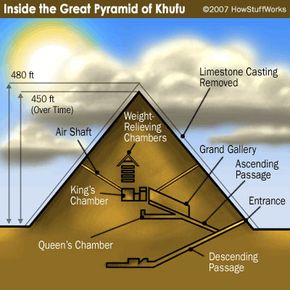The Great Pyramid of Giza
The Great Pyramid of Giza, also known as the Pyramid of Khufu, is the oldest pyramid in the Giza Plateau and is the only one of the Seven Wonders of the Ancient World still standing. It was built for Pharaoh Khufu around 2600 B.C.E. The two smaller pyramids nearby were for Khufu's son, Khafre, and his grandson, Menkaure. After this dynasty, great pyramid building stopped, probably because of the time and expense of these massive state projects.
The Great Pyramid of Giza on the Giza plateau in Egypt is the largest and most elaborately constructed pyramid in existence, representing the most advanced aspects of pyramid construction. Khufu's pyramid has the following features:
Advertisement
- A cramped ascending chamber that opens suddenly into a space known as the Grand Gallery.
- The Grand Gallery has a vaulted, corbeled 26-foot (8.74-meter) ceiling that leads up to the King's Chamber.
- The King's chamber is constructed of red granite from the southern quarries at Aswan.
- Weight-relieving chambers above the king's chamber distribute the weight of the overlying rock and prevent the king's chamber from collapsing.
- Descending and ascending passageways connect various chambers to each other and to the outside.
- Air shafts connect the king's chamber to the outside. They may have been designed as a way for Khufu's spirit to exit the pyramid and rise to the heavens.
- The entrancewas sealed after the pharaoh's body was placed inside.
- White limestone rocks line the pyramid's exterior, giving it a smooth face. These rocks have eroded away over time, but we know they existed because the Pyramid of Khafre still has some on its peak.
